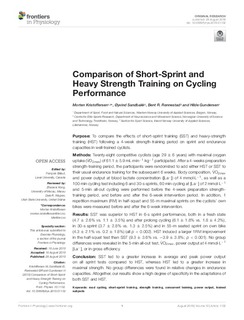| dc.contributor.author | Kristoffersen, Morten | |
| dc.contributor.author | Sandbakk, Øyvind | |
| dc.contributor.author | Rønnestad, Bent | |
| dc.contributor.author | Gundersen, Hilde | |
| dc.coverage.spatial | Norway | nb_NO |
| dc.date.accessioned | 2020-01-31T13:21:16Z | |
| dc.date.available | 2020-01-31T13:21:16Z | |
| dc.date.created | 2019-10-03T19:07:43Z | |
| dc.date.issued | 2019 | |
| dc.identifier.citation | Kristoffersen, M., Sandbakk, Ø., Rønnestad, B. R., & Gundersen, H. (2019). Comparison of short-sprint and heavy strength training on cycling performance. Frontiers in Physiology, 10. | nb_NO |
| dc.identifier.issn | 1664-042X | |
| dc.identifier.uri | http://hdl.handle.net/11250/2639086 | |
| dc.description.abstract | Purpose: To compare the effects of short-sprint training (SST) and heavy-strength training (HST) following a 4-week strength-training period on sprint and endurance capacities in well-trained cyclists.
Methods: Twenty-eight competitive cyclists (age 29 ± 6 years) with maximal oxygen uptake (www.frontiersin.org) of 61.1 ± 5.9 mL⋅min–1⋅kg–1 participated. After a 4-weeks preparation strength-training period, the participants were randomized to add either HST or SST to their usual endurance training for the subsequent 6 weeks. Body composition, www.frontiersin.org and power output at blood lactate concentration ([La–]) of 4 mmol⋅L–1, as well as a 100 min cycling test including 6 and 30-s sprints, 60 min cycling at [La–] of 2 mmol⋅L–1 and 5-min all-out cycling were performed before the 4-week preparation strength-training period, and before and after the 6-week intervention period. In addition, 1 repetition maximum (RM) in half-squat and 55-m maximal sprints on the cyclists’ own bikes were measured before and after the 6-week intervention.
Results: SST was superior to HST in 6-s sprint performance, both in a fresh state (4.7 ± 2.6% vs. 1.1 ± 3.5%) and after prolong cycling (6.1 ± 1.8% vs. 1.8 ± 4.2%), in 30-s sprint (3.7 ± 2.8% vs. 1.3 ± 2.5%) and in 55-m seated sprint on own bike (4.3 ± 2.1% vs. 0.2 ± 1.8%) (all p < 0.002). HST induced a larger 1RM improvement in the half-squat test than SST (9.3 ± 3.6% vs. −3.9 ± 3.8%; p < 0.001). No group differences were revealed in the 5-min all-out test, www.frontiersin.org, power output at 4 mmol⋅L–1 [La–], or in gross efficiency.
Conclusion: SST led to a greater increase in average and peak power output on all sprint tests compared to HST, whereas HST led to a greater increase in maximal strength. No group differences were found in relative changes in endurance capacities. Altogether, our results show a high degree of specificity in the adaptations of both SST and HST. | nb_NO |
| dc.language.iso | eng | nb_NO |
| dc.publisher | Frontiers | nb_NO |
| dc.rights | Navngivelse 4.0 Internasjonal | * |
| dc.rights.uri | http://creativecommons.org/licenses/by/4.0/deed.no | * |
| dc.subject | road cycling | nb_NO |
| dc.subject | short-sprint training | nb_NO |
| dc.subject | strength training | nb_NO |
| dc.subject | concurrent training | nb_NO |
| dc.subject | power output | nb_NO |
| dc.subject | trained subjects | nb_NO |
| dc.title | Comparison of Short-Sprint and Heavy Strength Training on Cycling Performance | nb_NO |
| dc.type | Journal article | nb_NO |
| dc.type | Peer reviewed | nb_NO |
| dc.description.version | publishedVersion | nb_NO |
| dc.rights.holder | Copyright © 2019 Kristoffersen, Sandbakk, Rønnestad and Gundersen. | nb_NO |
| dc.subject.nsi | VDP::Medisinske Fag: 700::Idrettsmedisinske fag: 850::Treningslære: 851 | nb_NO |
| dc.source.pagenumber | 9 | nb_NO |
| dc.source.volume | 10 | nb_NO |
| dc.source.journal | Frontiers in Physiology | nb_NO |
| dc.identifier.doi | 10.3389/fphys.2019.01132 | |
| dc.identifier.cristin | 1733724 | |
| cristin.unitcode | 203,10,1,0 | |
| cristin.unitname | Institutt for idrett, kosthald og naturfag | |
| cristin.ispublished | true | |
| cristin.fulltext | original | |
| cristin.qualitycode | 1 | |

